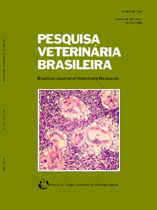 |
|
|
|
Ano 2010 - Volume 30, Número 3
|

|
Intoxicação experimental por Brachiaria decumbens em ovinos confinados, 30(3):195-202
|
ABSTRACT.- Saturnino K.C., Mariani T.M., Barbosa-Ferreira M., Brum K.B., Fernandes C.E.S. & Lemos R.A.A. 2010. [Experimental poisoning by Brachiaria decumbens in feedlot sheep.] Intoxicação experimental por Brachiaria decumbens em ovinos confinados. Pesquisa Veterinária Brasileira 30(3):195-202. Departamento de Medicina Veterinária, Faculdade de Medicina Veterinária e Zootecnia, Universidade Federal de Mato Grosso do Sul, Campo Grande, MS 79070-900, Brazil. E-mail: rlemos@nin.ufms.br
Brachiaria decumbens was fed as exclusive source of food to feedlot sheep. Sheep were evaluated in three periods of the year, of 60 days each, regarding their clinical status and was performed collection of blood samples to measure enzymatic activity of gamma glutamyltransferase and aspartate aminotransferase to evaluate their diagnostic importance and usefulness besides the clinical signs, necropsy and histopathology finds in hepatogenous photosensitization Brachiaria related. Out of 24 feedlot sheep, five died in the first period (February-April), four in the second (June-August) and two in the third (October-December). Main clinical signs were anorexia, jaundice, photophobia and two cases of slight dermatitis, besides dehydration, apathy and corneal opacity. Necropsy revealed generalized jaundice, distended gall bladder and liver with evident lobular pattern. The histological changes varied in severity according the time after the beginning of the plant ingestion; they were more significant in the liver and included bilestasis, swelling and vacuolation of hepatocytes, foammy macrophages, bile duct proliferation and mononuclear inflammatory cell infiltration, further crystal negative images were found within cytoplasm of macrophages present inside of hepatic sinusoid and in the periportal space and also optically active refringent crystal in the lumen of bile tubules. These finds are characteristic of hepatogenous photosensitization, mainly by presence of photophobia, even when the sheep did not present photodermatitis. The results of serum biochemistry activity, during the course of poisoning with strong relation between increased gamma glutamyltransferase activity, and lethality. Onset of arising gama glutamyltransferase activity was 11 days, in average, before beginning of clinical signs. Aspartate aminotransferase had increased activity only close to the beginning of clinical signs. Serum biochemistry results of GGT suggest that they are useful for a precocious diagnosis preventing deaths caused by ingestion of B. decumbens. Thirteen sheep didn’t show clinical signs despite significant increases on serum enzyme activity, suggesting the existence of tolerant/resistant individuals. The experimental model of feedlot was adequate to study B. decumbens toxicosis in sheep. |
| |
|
|
| |
|
 |